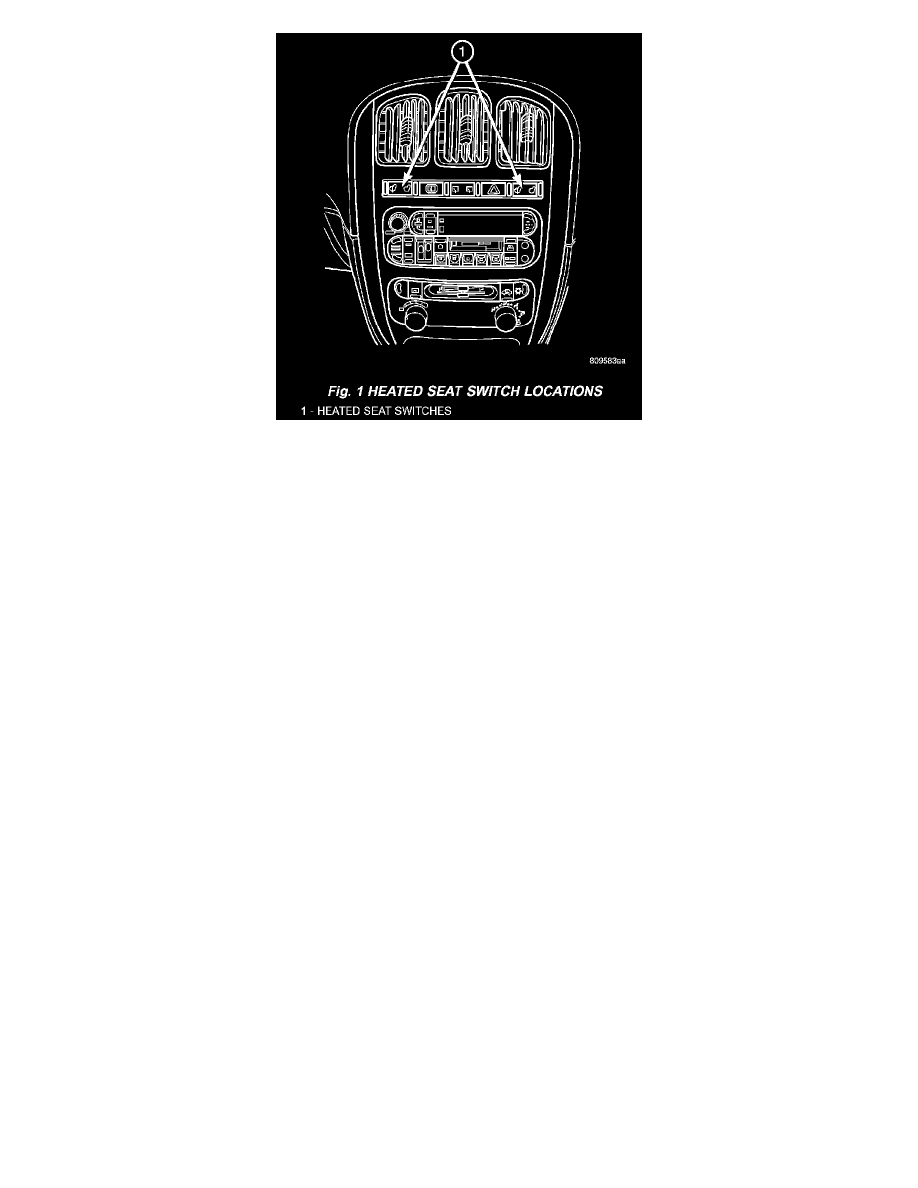Caravan L4-2.4L VIN B (2003)

Fig.1 Heated Seat Switch Locations
DRIVER HEATED SEAT SWITCH
The heated seat switches are mounted in the instrument panel center bezel. The two three position rocker-type switches, one switch for each front
seat, are incorporated into one large switch assembly that also includes the hazard, rear window wiper and washer switches. The heated seat
switches provide a resistor multiplexed signal to the Heated Seat Module (HSM) through separate hard wired circuits. Each switch has an OFF,
Low, and High position so that both the driver and the front seat passenger can select a preferred seat heating mode. Each switch has two
Light-Emitting Diodes (LED) which light to indicate that the heater for the seat is turned on.
The heated seat switches and their LEDs cannot be repaired. If either switch or LED is faulty or damaged, the entire switch assembly must be
replaced.
There are three positions that can be selected with each of the heated seat switches: OFF, Low, or High. When the left side of the switch rocker is
fully depressed, the Low position is selected and the low position LED indicator illuminates. When the right side of the switch rocker is fully
depressed, the High position is selected and the high position LED indicator illuminates. When the switch rocker is moved to its neutral position
(middle), OFF is selected and both LED indicators are extinguished.
Both switches provide separate resistor multiplexed hard wire inputs to the Heated Seat Module (HSM) to indicate the selected switch position.
The heated seat module responds to the heated seat switch status messages by controlling the output to the seat heater elements of the selected seat.
The Low heat position set point is about 36 °C (97 °F), and the High heat position set point is about 41 °C (105 °F).
HEATED SEAT ELEMENT
The heated seat system includes two seat heating elements in each front seat, one for the seat cushion and the other for the seat back. The two
elements for each seat that are connected in series with the Heated Seat Module (HSM). The temperature sensor is a Negative Temperature
Coefficient (NTC) thermistor. One temperature sensor is used for each seat, and it is located on the seat cushion heating element for all models.
The seat heating elements are sewn into the seat cushion cover trim and seat back cover trim units. The heated seat elements and the temperature
sensor cannot be adjusted or repaired and, if faulty or damaged, the seat element assembly must be replaced. Refer to the procedure in this section.
The heated seat elements resist the flow of electrical current. When battery current is passed through the elements, the energy lost by the resistance
of the elements to the current flow is released in the form of heat. The temperature sensor is a NTC thermistor. When the temperature of the seat
cushion cover rises, the resistance of the sensor decreases. The heated seat module supplies a five-volt current to one side of each sensor, and
monitors the voltage drop through the sensor on a return circuit. The heated seat module uses this temperature sensor input to monitor the
temperature of the seat, and regulates the current flow to the seat heating elements accordingly.
HEATED SEAT SENSOR
Two heated seat sensors are used per vehicle, one in each front seat cushion heating element. The heated seat temperature sensor is a Negative
Temperature Coefficient (NTC) thermistor.
The heated seat sensors cannot be repaired or adjusted and if found to be faulty, the complete heated seat cushion element must be replaced.
The temperature sensor is a NTC thermistor. When the temperature of the seat cushion cover rises, the resistance of the sensor decreases. The
